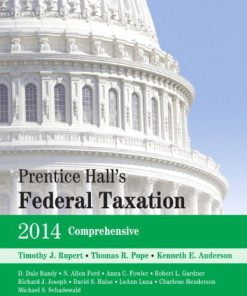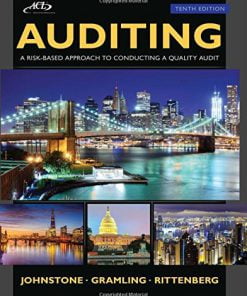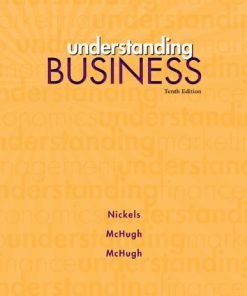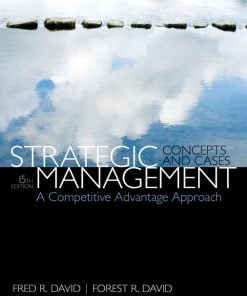Solution Manual For South-Western Federal Taxation 2019: Corporations, Partnerships, Estates And Trusts 42nd Edition
$35.00 Original price was: $35.00.$26.50Current price is: $26.50.
Solution Manual For South-Western Federal Taxation 2019: Corporations, Partnerships, Estates And Trusts 42nd Edition
This is completed downloadable of Solution Manual For South-Western Federal Taxation 2019: Corporations, Partnerships, Estates And Trusts 42nd Edition
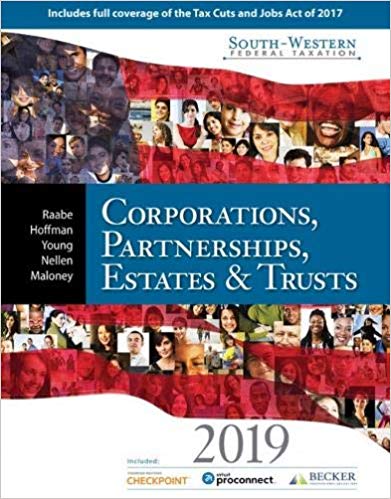
Product Details:
- ISBN-10 : 1337702919
- ISBN-13 : 978-1337702911
- Author: William A. Raabe (Author), William H. Hoffman (Author), James C. Young (Author), Annette Nellen (Author), David M. Maloney (Author)
Gain a thorough understanding of today’s tax concepts and ever-changing tax legislation with SOUTH-WESTERN FEDERAL TAXATION 2019: CORPORATIONS, PARTNERSHIPS, ESTATES & TRUSTS, 42E. This reader-friendly presentation provides the most effective solution to help you master tax concepts impacting contemporary corporations, partnerships, estates and trusts. You examine the most current tax legislation at the time of publication, including the Tax Cuts and Jobs Act of 2017. Extensive examples, summaries and meaningful tax scenarios clarify concepts and sharpen your critical-thinking, writing and research skills. The book’s framework effectively demonstrates how topics relate to one another and to the big picture. To ensure thorough coverage, each new book includes instant access to Intuit ProConnect tax software, Checkpoint (Student Edition) from Thomson Reuters and CengageNOWv2 optional online homework solution.
Table of Content:
- Part 1: Introduction
- CHAPTER 1 Understanding and Working with the Federal Tax Law
- The Big Picture: Importance of Tax Research
- THE WHYS OF THE TAX LAW
- Revenue Needs
- Economic Considerations
- Social Considerations
- Equity Considerations
- Political Considerations
- Influence of the Internal Revenue Service
- Influence of the Courts
- SUMMARY
- RECONCILING ACCOUNTING CONCEPTS
- WORKING WITH THE TAX LAW—TAX SOURCES
- Statutory Sources of the Tax Law
- Administrative Sources of the Tax Law
- Judicial Sources of the Tax Law
- Concept Summary: Federal Judicial System
- Concept Summary: Judicial Sources
- Other Sources of the Tax Law
- WORKING WITH THE TAX LAW—LOCATING AND USING TAX SOURCES
- Commercial Tax Services
- Financial Disclosure Insights: Where Does GAAP Come From?
- Using Electronic (Online) Tax Services
- Noncommercial Electronic (Online) Tax Sources
- WORKING WITH THE TAX LAW—TAX RESEARCH
- Identifying the Problem
- Locating the Appropriate Tax Law Sources
- Assessing the Validity of Tax Law Sources
- Ethics & Equity: Choosing Cases for Appeal
- Arriving at the Solution or at Alternative Solutions
- Communicating Tax Research
- WORKING WITH THE TAX LAW—TAX PLANNING
- Nontax Considerations
- Components of Tax Planning
- Follow-Up Procedures
- Tax Planning—A Practical Application
- TAXATION ON THE CPA EXAMINATION
- Preparation Blueprints
- Regulation Section
- CHAPTER 2 The Deduction for Qualified Business Income for Pass-Through Entities
- The Big Picture: Entrepreneurial Pursuits
- TAX TREATMENT OF VARIOUS BUSINESS FORMS
- Sole Proprietorships
- Partnerships
- Corporations
- Concept Summary: Tax Treatment of Business Forms Compared
- Global Tax Issues: U.S. Corporate Taxes and International Business Competitiveness
- Limited Liability Companies
- THE TAX CUTS AND JOBS ACT (TCJA) OF 2017 AND ENTITY TAX RATES
- Challenges of Lowering Tax Rates
- Lowering Tax Rates for Different Business Forms
- THE DEDUCTION FOR QUALIFIED BUSINESS INCOME
- General Rule
- The Overall Limitation: Modified Taxable Income
- Definition of Qualified Business Income
- Definition of a Qualified Trade or Business
- Limitations on the QBI Deduction
- Limitation Based on Wages and Capital Investment
- Concept Summary: An Overview of the Qualified Business Income Deduction
- Limitation for “Specified Services” Businesses
- Treatment of Losses
- Coordination with Other Rules
- Considerations for Partnerships and S Corporations
- Open Issues
- TAX PLANNING
- Corporate versus Noncorporate Forms of Business Organization
- Optimizing the Deduction for Qualified Business Income
- Refocus on the Big Picture: Entrepreneurial Pursuits
- Part 2: Corporations
- CHAPTER 3 Corporations: Introduction and Operating Rules
- The Big Picture: A Half-Baked Idea?
- AN INTRODUCTION TO THE INCOME TAXATION OF CORPORATIONS
- An Overview of Corporate versus Individual Income Tax Treatment
- Specific Provisions Compared
- Accounting Periods and Methods
- Capital Gains and Losses
- Recapture of Depreciation
- Business Interest Expense Limitation
- Passive Activity Losses
- Concept Summary: Special Rules Applicable to Personal Service Corporations (PSCs)
- Charitable Contributions
- Excessive Executive Compensation
- Net Operating Losses
- Deductions Available Only to Corporations
- Ethics & Equity: Pushing the Envelope on Year-End Planning
- Concept Summary: Income Taxation of Individuals and Corporations Compared
- DETERMINING THE CORPORATE INCOME TAX LIABILITY
- Corporate Income Tax Rates
- Alternative Minimum Tax
- Restrictions on Corporate Accumulations
- PROCEDURAL MATTERS
- Filing Requirements for Corporations
- Estimated Tax Payments
- Schedule M–1—Reconciliation of Income (Loss) per Books with Income per Return
- Concept Summary: Conceptual Diagram of Schedule M–1 (Form 1120)
- Schedule M–2—Analysis of Unappropriated Retained Earnings per Books
- Schedule M–3—Net Income (Loss) Reconciliation for Corporations with Total Assets of $10 Million
- Effect of Taxes on the Financial Statements
- Form 1120 Illustrated
- Consolidated Returns
- TAX PLANNING
- Corporate versus Noncorporate Forms of Business Organization
- Operating the Corporation
- Refocus on the Big Picture: Cooked to Perfection
- CHAPTER 4 Corporations: Organization and Capital Structure
- The Big Picture: The Vehicle for Business Growth Is the Corporate Form
- ORGANIZATION OF AND TRANSFERS TO CONTROLLED CORPORATIONS
- Section 351 Rationale and General Rules
- Global Tax Issues: Tax Reform Adds a New Wrinkle to the Choice of Organizational Form When Operating
- Concept Summary: Shareholder Consequences: Taxable Corporate Formation versus Tax-Deferred § 351 Tr
- Property Defined
- Stock Transferred
- Control of the Corporation
- Assumption of Liabilities—§ 357
- Basis Determination and Related Issues
- Concept Summary: Tax Consequences of Liability Assumption
- Concept Summary: Tax Consequences to the Shareholders and Corporation: With and Without the Applicat
- CAPITAL STRUCTURE OF A CORPORATION
- Capital Contributions
- Debt in the Capital Structure
- INVESTOR LOSSES
- Stock and Security Losses
- Ethics & Equity: Can a Loss Produce a Double Benefit?
- Business versus Nonbusiness Bad Debts
- Section 1244 Stock
- GAIN FROM QUALIFIED SMALL BUSINESS STOCK
- TAX PLANNING
- Working with § 351
- Selecting Assets to Transfer
- Debt in the Capital Structure
- Investor Losses
- Refocus on the Big Picture: The Vehicle for Business Growth Is the Corporate Form
- CHAPTER 5 Corporations: Earnings & Profits and Dividend Distributions
- The Big Picture: Taxing Corporate Distributions
- CORPORATE DISTRIBUTIONS—OVERVIEW
- EARNINGS AND PROFITS (E & P)—§ 312
- Computation of E & P
- Summary of E & P Adjustments
- Concept Summary: E & P Adjustments
- Current versus Accumulated E & P
- Allocating E & P to Distributions
- Concept Summary: Allocating E & P to Distributions
- Ethics & Equity: Shifting E & P
- DIVIDENDS
- Rationale for Reduced Tax Rates on Dividends
- Qualified Dividends
- Property Dividends
- Concept Summary: Noncash Property Distributions
- Constructive Dividends
- Stock Dividends and Stock Rights
- TAX PLANNING
- Corporate Distributions
- Planning for Qualified Dividends
- Constructive Dividends
- Refocus on the Big Picture: Taxing Corporate Distributions
- CHAPTER 6 Corporations: Redemptions and Liquidations
- The Big Picture: Family Corporations and Stock Redemptions
- STOCK REDEMPTIONS—IN GENERAL
- STOCK REDEMPTIONS—SALE OR EXCHANGE TREATMENT
- Global Tax Issues: Foreign Shareholders Prefer Sale or Exchange Treatment in Stock Redemptions
- Concept Summary: Tax Consequences of Stock Redemptions to Shareholders
- Historical Background and Overview
- Stock Attribution Rules
- Not Essentially Equivalent Redemptions
- Disproportionate Redemptions
- Complete Termination Redemptions
- Partial Liquidations
- Redemptions to Pay Death Taxes
- Concept Summary: Summary of the Qualifying Stock Redemption Rules
- STOCK REDEMPTIONS—EFFECT ON THE CORPORATION
- Recognition of Gain or Loss
- Effect on Earnings and Profits
- Redemption Expenditures
- STOCK REDEMPTIONS—PREFERRED STOCK BAILOUTS
- Background
- Tax Consequences
- Section 306 Stock
- LIQUIDATIONS—IN GENERAL
- The Liquidation Process
- Liquidating and Nonliquidating Distributions Compared
- LIQUIDATIONS—EFFECT ON THE DISTRIBUTING CORPORATION
- The General Rule
- Antistuffing Rules
- Concept Summary: Summary of Antistuffing Loss Disallowance Rules
- LIQUIDATIONS—EFFECT ON THE SHAREHOLDER
- Ethics & Equity: Transferee Liability for Tax Deficiency of Liquidated Corporation
- LIQUIDATIONS—PARENT-SUBSIDIARY SITUATIONS
- Minority Shareholder Interests
- Global Tax Issues: Basis Rules for Liquidations of Foreign Subsidiaries
- Indebtedness of the Subsidiary to the Parent
- Basis of Property Received by the Parent Corporation—The General Rule
- Basis of Property Received by the Parent Corporation—§ 338 Election
- Concept Summary: Summary of Liquidation Rules
- TAX PLANNING
- Stock Redemptions
- Corporate Liquidations
- Parent-Subsidiary Liquidations
- Asset Purchase versus Stock Purchase
- Refocus on the Big Picture: A Family Attribution Waiver Is a Valuable Tool in Succession Planning
- CHAPTER 7 Corporations: Reorganizations
- The Big Picture: Structuring Acquisitions
- REORGANIZATIONS—IN GENERAL
- Summary of the Different Types of Reorganizations
- Summary of Tax Consequences in a Tax-Free Reorganization
- Concept Summary: Gain and Basis Rules for Nontaxable Exchanges
- Concept Summary: Basis to Acquiring Corporation of Property Received
- TYPES OF TAX-FREE REORGANIZATIONS
- Type A
- Type B
- Type C
- Type D
- Type E
- Concept Summary: Summary of Type A Through Type D Reorganizations: Advantages and Disadvantages
- Type F
- Type G
- JUDICIAL DOCTRINES
- Sound Business Purpose
- Continuity of Interest
- Continuity of Business Enterprise
- Global Tax Issues: Acquisition Prescription to Lower Taxes Has Expired
- Step Transaction
- Ethics & Equity: Voicing Ethical Values
- Financial Disclosure Insights: When an Acquisition Fails
- TAX ATTRIBUTE CARRYOVERS
- Assumption of Liabilities
- Allowance of Carryovers
- Net Operating Loss Carryovers
- Earnings and Profits
- Other Carryovers
- Concept Summary: Treatment of E & P Carried to Successor
- TAX PLANNING
- Assessing the Possible Benefits of Restructuring Options
- Concept Summary: Summary of Carryover Rules
- Concept Summary: Comprehensive Summary of Corporate Reorganizations
- Refocus on the Big Picture: Structuring Acquisitions
- CHAPTER 8 Consolidated Tax Returns
- The Big Picture: A Corporation Contemplates a Merger
- THE CONSOLIDATED RETURN RULES
- Motivations to Consolidate
- Source and Philosophy of Consolidated Return Rules
- Ethics & Equity: Delegating Authority to the Nonelected
- ASSESSING CONSOLIDATED RETURN STATUS
- Financial Disclosure Insights: GAAP and Tax Treatment of Consolidations
- ELECTING CONSOLIDATED RETURN STATUS
- Concept Summary: The Consolidated Return Election
- Affiliated Group
- Affiliated versus Controlled Group
- Eligibility for the Consolidation Election
- Compliance Requirements
- State Tax Effects
- Concept Summary: The Consolidated Tax Return
- STOCK BASIS OF SUBSIDIARY
- COMPUTING CONSOLIDATED TAXABLE INCOME
- Computational Procedure
- Typical Intercompany Transactions
- Global Tax Issues: Consolidated Returns and NOLs
- Computation of Group Items
- The Matching Rule
- Concept Summary: The Consolidated Taxable Income
- TAX PLANNING
- Choosing Consolidated Return Partners
- Consolidation versus 100 Percent Dividends Received Deduction
- Protecting the Group Members’ Liability for Tax Payments
- Documentation Requirements
- Refocus on the Big Picture: Should the Affiliated Group File a Consolidated Return?
- CHAPTER 9 Taxation of International Transactions
- The Big Picture: Going International
- OVERVIEW OF INTERNATIONAL TAXATION
- Global Tax Issues: Tax Reform Can Make Strange Bedfellows
- TAX TREATIES
- SOURCING OF INCOME AND DEDUCTIONS
- U.S.-Source Income
- Foreign-Source Income
- Allocation and Apportionment of Deductions
- Concept Summary: The Sourcing Rules
- Transfer Pricing
- Ethics & Equity: The Costs of Good Tax Planning
- FOREIGN CURRENCY TRANSACTIONS
- Tax Issues
- Concept Summary: Recognition of Foreign Exchange Gain or Loss
- Functional Currency
- Branch Operations
- Distributions from Foreign Corporations
- Foreign Taxes
- U.S. PERSONS WITH OFFSHORE INCOME
- Export Property, Licenses, Foreign Branches
- Financial Disclosure Insights: Overseas Operations and Book-Tax Differences
- Concept Summary: The Foreign Tax Credit
- Creating a Cross-Border Business Entity
- Tax Havens
- Offshore (Foreign) Corporations Controlled by U.S. Persons
- Concept Summary: Subpart F Income and a CFC
- Movement Toward a Territorial System
- Concept Summary: Income of a CFC That Is Included in Gross Income of a U.S. Shareholder, Selected
- U.S. TAXATION OF NONRESIDENT ALIENS AND FOREIGN CORPORATIONS
- Nonresident Alien Individuals
- Foreign Corporations
- Foreign Investment in Real Property Tax Act
- Expatriation to Avoid U.S. Taxation
- REPORTING REQUIREMENTS
- TAX PLANNING
- The Foreign Tax Credit Limitation and Sourcing Provisions
- Transfer Pricing
- Refocus on the Big Picture: Going International
- Part 3: Flow-Through Entities
- CHAPTER 10 Partnerships: Formation, Operation, and Basis
- The Big Picture: Why Use a Partnership, Anyway?
- OVERVIEW OF PARTNERSHIP TAXATION
- What Is a Partnership?
- Concept Summary: Comparison of Partnership Types
- Key Concepts in Taxation of Partnership Income
- FORMATION OF A PARTNERSHIP: TAX EFFECTS
- Contributions to the Partnership
- Exceptions to the General Rule of § 721
- Other Issues Related to Contributed Property
- Concept Summary: Partnership Formation and Initial Basis Computation
- Tax Accounting Elections
- Initial Costs of a Partnership
- Method of Accounting
- Taxable Year of the Partnership
- OPERATIONS OF THE PARTNERSHIP
- Measuring and Reporting Partnership Income
- Global Tax Issues: Withholding Requirements for non-U.S. Partners
- Partner Allocations and Reporting
- Concept Summary: Tax Reporting of Partnership Items
- Ethics & Equity: Built-In Appreciation on Contributed Property
- Partner’s Basis
- Partner’s Capital Account
- Loss Limitations
- OTHER ISSUES
- Self-Employment and Net Investment Income Tax
- Transactions between a Partner and a Partnership
- TAX PLANNING
- Choosing Partnership Taxation
- Concept Summary: Major Advantages and Disadvantages of the Partnership Form
- Formation and Operation of a Partnership
- Basis Considerations and Loss Deduction Limitations
- Partnership Reporting Requirements
- Transactions between Partners and Partnerships
- Drafting the Partnership Agreement
- Refocus on the Big Picture: Why Use a Partnership, Anyway?
- CHAPTER 11 Partnerships: Distributions, Transfer of Interests, and Terminations
- The Big Picture: The Life Cycle of a Partnership
- DISTRIBUTIONS FROM A PARTNERSHIP
- Distributions in General
- Proportionate Current Distributions
- Ethics & Equity: Arranging Tax-Advantaged Distributions
- Proportionate Liquidating Distributions
- Concept Summary: Proportionate Current Distributions (General Rules)
- Property Distributions with Special Tax Treatment
- Concept Summary: Proportionate Liquidating Distributions When the Partnership Also Liquidates (Gener
- Disproportionate Distributions
- SECTION 736—LIQUIDATING DISTRIBUTIONS TO RETIRING OR DECEASED PARTNERS
- Treatment of Property/Income Payments
- Property Payments
- Income Payments
- Concept Summary: Liquidating Distributions of Cash When the Partnership Continues
- SALE OF A PARTNERSHIP INTEREST
- General Rules
- Hot Assets and Carried Interests
- Concept Summary: Sale of a Partnership Interest
- OTHER DISPOSITIONS OF PARTNERSHIP INTERESTS
- Transfers to a Corporation
- Like-Kind Exchanges
- Death of a Partner
- Gifts
- SECTION 754—OPTIONAL ADJUSTMENTS TO PROPERTY BASIS
- Adjustment: Sale or Exchange of an Interest
- Adjustment: Partnership Distributions
- Concept Summary: Basis Adjustments under § 754
- TERMINATION OF A PARTNERSHIP
- OTHER ISSUES
- Family Partnerships
- Global Tax Issues: Sale of Global Partnership Interests
- Limited Liability Companies
- Limited Liability Partnerships
- Partnership Administration and Anti-Abuse
- TAX PLANNING
- Planning Partnership Distributions
- Sales and Exchanges of Partnership Interests
- Comparing Sales to Liquidations
- Other Partnership Issues
- Refocus on the Big Picture: The Life Cycle of a Partnership
- CHAPTER 12 S Corporations
- The Big Picture: Deductibility of Losses and the Choice of Business Entity
- CHOICE OF BUSINESS ENTITY
- Concept Summary: Making an S Election
- An Overview of S Corporations
- QUALIFYING FOR S CORPORATION STATUS
- Definition of a Small Business Corporation
- Making the Election
- Shareholder Consent
- Loss of the Election
- OPERATIONAL RULES
- Computation of Taxable Income
- Qualified Business Income Deduction
- Allocation of Income and Loss
- Tax Treatment of Distributions to Shareholders
- Concept Summary: Classification Procedures for Distributions from an S Corporation
- Tax Treatment of Noncash Property Distributions by the Corporation
- Concept Summary: Consequences of Noncash Distributions
- Shareholder’s Basis in S Stock
- Treatment of Losses
- Tax on Pre-Election Built-In Gain
- Passive Investment Income Penalty Tax
- Other Operational Rules
- TAX PLANNING
- When the Election Is Advisable
- Making a Proper Election
- Preserving the Election
- Planning for the Operation of the Corporation
- Refocus on the Big Picture: Using a Pass-Through Entity to Achieve Deductibility of Losses
- Part 4: Advanced Tax Practice Considerations
- CHAPTER 13 Comparative Forms of Doing Business
- The Big Picture: Selection of a Tax Entity Form
- FORMS OF DOING BUSINESS
- NONTAX FACTORS
- Capital Formation
- Limited Liability
- Other Factors
- SINGLE VERSUS DOUBLE TAXATION
- Overall Effect on Entity and Owners
- Alternative Minimum Tax
- State Taxation
- Global Tax Issues: Tax Rates and Economic Activity
- CONTROLLING THE ENTITY TAX
- Favorable Treatment of Certain Fringe Benefits
- Minimizing Double Taxation
- Considering the Qualified Business Income Deduction
- CONDUIT VERSUS ENTITY TREATMENT
- Effect on Recognition at Time of Contribution to the Entity
- Effect on Basis of Ownership Interest
- Ethics & Equity: Income Tax Basis That Does Not Change?
- Effect on Results of Operations
- Effect on Recognition at Time of Distribution
- Effect on Passive Activity Losses
- Effect of At-Risk Rules
- Effect of Special Allocations
- FICA, SELF-EMPLOYMENT TAXES, AND NIIT
- FICA
- Self-Employment Tax
- Net Investment Income Tax (NIIT)
- Effect on the Entity and Its Owners
- DISPOSITION OF A BUSINESS OR AN OWNERSHIP INTEREST
- Sole Proprietorship
- Partnership and Limited Liability Company
- C Corporation
- S Corporation
- CONVERTING TO OTHER ENTITY TYPES
- Sole Proprietorship
- C Corporation
- Partnership or LLC
- OVERALL COMPARISON OF FORMS OF DOING BUSINESS
- Concept Summary: Tax Attributes of Different Forms of Business (Assume That Partners and Shareholder
- TAX PLANNING
- Refocus on the Big Picture: Selection of a Tax Entity Form
- CHAPTER 14 Taxes on the Financial Statements
- The Big Picture: Taxes on the Financial Statements
- BOOK-TAX DIFFERENCES
- Different Reporting Entities
- Different Taxes
- Different Methods
- Tax Return Disclosures
- Financial Disclosure Insights: Supersized Goodwill
- Concept Summary: Income Amounts—Book versus Tax
- INCOME TAXES IN THE FINANCIAL STATEMENTS
- GAAP Principles
- Global Tax Issues: Accounting for Income Taxes in International Standards
- Financial Disclosure Insights: The Book-Tax Income Gap
- Valuation Allowance
- Global Tax Issues: Tax Losses and the Deferred Tax Asset
- Tax Disclosures in the Financial Statements
- Concept Summary: Steps in Determining the Book Tax Expense
- Special Issues
- Concept Summary: Disclosures Under ASC 740-10
- Ethics & Equity: Disclosing Aggressive Tax Positions
- Summary
- BENCHMARKING
- Refining the Analysis
- Sustaining the Tax Rate
- Uses of Benchmarking Analysis
- Concept Summary: Benchmarking Analysis
- TAX PLANNING
- Releasing Valuation Allowances
- Comparing Tax Savings
- Refocus on the Big Picture: Taxes on the Financial Statements
- CHAPTER 15 Exempt Entities
- The Big Picture: Effect of a For-Profit Business on a Tax-Exempt Entity
- TYPES OF EXEMPT ORGANIZATIONS
- REQUIREMENTS FOR EXEMPT STATUS
- Serving the Common Good
- Not-for-Profit Entity
- Net Earnings and Members of the Organization
- TAXES ON EXEMPT ENTITIES
- Prohibited Transactions
- Feeder Organizations
- Concept Summary: Consequences of Exempt Status
- PRIVATE FOUNDATIONS
- Tax Consequences of Private Foundation Status
- Concept Summary: Exempt Organizations: Classification
- Taxes Imposed on Private Foundations
- UNRELATED BUSINESS INCOME TAX
- Unrelated Trade or Business
- Unrelated Business Taxable Income
- Concept Summary: Unrelated Business Income Tax
- REPORTING REQUIREMENTS
- Obtaining Exempt Organization Status
- Annual Filing Requirements
- Disclosure Requirements
- TAX PLANNING
- General Considerations
- Maintaining Exempt Status
- Private Foundation Status
- Unrelated Business Income Tax
- Refocus on the Big Picture: Effect of a For-Profit Business on a Tax-Exempt Entity
- CHAPTER 16 Multistate Corporate Taxation
- The Big Picture: Making a Multistate Location Decision
- OVERVIEW OF CORPORATE STATE INCOME TAXATION
- Computing State Income Tax
- State Modifications
- The UDITPA and the Multistate Tax Commission
- Jurisdiction to Impose Tax: Nexus and Public Law 86–272
- Nexus beyond P.L. 86–272
- Concept Summary: Multistate Taxation
- ALLOCATION AND APPORTIONMENT OF INCOME
- The Apportionment Procedure
- Apportionable Income
- Apportionment Factors: Elements and Planning
- Concept Summary: Apportionable Income
- The Sales Factor
- The Payroll Factor
- The Property Factor
- Financial Disclosure Insights: State/Local Taxes and the Tax Expense
- THE UNITARY THEORY
- What Is a Unitary Business?
- Tax Effects of the Unitary Theory
- Consolidated and Combined Returns
- Concept Summary: Using Apportionment Formulas
- Global Tax Issues: Water’s Edge Is Not a Day at the Beach
- TAXATION OF S CORPORATIONS
- Eligibility
- State Tax Filing Requirements
- TAXATION OF PARTNERSHIPS AND LLCS
- OTHER STATE AND LOCAL TAXES
- State and Local Sales and Use Taxes
- Local Property Taxes
- Other Taxes
- Ethics & Equity: Encouraging Economic Development through Tax Concessions
- TAX PLANNING
- Selecting the Optimal State in Which to Operate
- Restructuring Corporate Entities
- Subjecting the Corporation’s Income to Apportionment
- Ethics & Equity: Can You Be a Nowhere Adviser?
- Planning with Apportionment Factors
- Sales/Use Tax Compliance
- Sales/Use Taxes on Capital Changes
- Capital Stock Taxation
- Refocus on the Big Picture: Making a Multistate Location Decision
- CHAPTER 17 Tax Practice and Ethics
- The Big Picture: A Tax Adviser’s Dilemma
- TAX ADMINISTRATION
- Organizational Structure of the IRS
- IRS Procedure—Letter Rulings
- IRS Procedure—Other Issuances
- Ethics & Equity: Tax Compliance Costs
- Administrative Powers of the IRS
- The Audit Process
- Ethics & Equity: Can the IRS Pretend to Be Your Friend?
- The Taxpayer Appeal Process
- Offers in Compromise and Closing Agreements
- Ethics & Equity: Our Taxing System of Self-Assessment
- Interest
- Concept Summary: Working with the IRS
- Taxpayer Penalties
- Ethics & Equity: First-Time Tax Violators Can Get Off with Just a Warning
- Statute of Limitations
- THE TAX PROFESSION AND TAX ETHICS
- The Tax Professional
- Regulating Tax Preparers
- IRS Rules Governing Tax Practice
- Preparer Penalties
- Privileged Communications
- AICPA Statements on Standards for Tax Services
- Concept Summary: Tax Profession and Ethics
- TAX PLANNING
- Strategies in Seeking a Letter Ruling
- Considerations in Handling an IRS Audit
- Statute of Limitations
- Litigation Considerations
- Penalties
- Privileged Communications
- Refocus on the Big Picture: A Tax Adviser’s Dilemma
- Part 5: Family Tax Planning
- CHAPTER 18 The Federal Gift and Estate Taxes
- The Big Picture: An Eventful and Final Year
- TRANSFER TAXES—IN GENERAL
- Nature of the Taxes
- Global Tax Issues: U.S. Transfer Taxes and NRAs
- Concept Summary: Formula for the Federal Gift Tax
- Concept Summary: Formula for the Federal Estate Tax
- Valuation for Federal Transfer Tax Purposes
- Key Property Concepts
- THE FEDERAL GIFT TAX
- General Considerations
- Ethics & Equity: It’s the Thought That Counts
- Transfers Subject to the Gift Tax
- Annual Exclusion
- Deductions
- Computing the Federal Gift Tax
- Procedural Matters
- Concept Summary: Federal Gift Tax Provisions
- THE FEDERAL ESTATE TAX
- Gross Estate
- Concept Summary: Federal Estate Tax Provisions—Gross Estate
- Taxable Estate
- Estate Tax Credits
- Global Tax Issues: Treaty Relief Is Not Abundant!
- Procedural Matters
- Concept Summary: Federal Estate Tax Provisions—Taxable Estate and Procedural Matters
- THE GENERATION-SKIPPING TRANSFER TAX
- The Problem
- The Solution
- TAX PLANNING
- Refocus on the Big Picture: An Eventful and Final Year
- CHAPTER 19 Family Tax Planning
- The Big Picture: Lifetime Giving—the Good and the Bad
- VALUATION CONCEPTS
- Valuation in General
- Valuation of Specific Assets
- Ethics & Equity: One Way to Handle Loans to Troublesome In-Laws
- Ethics & Equity: Can IRS Valuation Tables Be Disregarded?
- Real Estate and the Special Use Valuation Method
- Valuation Problems with a Closely Held Business
- Concept Summary: Valuation Concepts
- INCOME TAX CONCEPTS
- Basis of Property Acquired by Gift
- Basis of Property Acquired by Death
- Concept Summary: Income Tax Concepts
- GIFT PLANNING
- Minimizing Gift Taxes
- Minimizing Estate Taxes
- Income Tax Considerations
- ESTATE PLANNING
- Probate Costs
- Proper Handling of Estate Tax Deductions
- Providing Estate Liquidity
- Concept Summary: Estate and Gift Tax Planning
- Refocus on the Big Picture: Lifetime Giving—the Good and the Bad
- CHAPTER 20 Income Taxation of Trusts and Estates
- The Big Picture: Setting Up a Trust to Protect a Family
- AN OVERVIEW OF FIDUCIARY TAXATION
- What Is a Trust?
- What Is an Estate?
- NATURE OF TRUST AND ESTATE TAXATION
- Concept Summary: Tax Characteristics of Major Pass-Through Entities
- Tax Accounting Periods and Methods
- Tax Rates and Personal Exemption
- Alternative Minimum Tax
- Additional Tax on Net Investment Income
- TAXABLE INCOME OF TRUSTS AND ESTATES
- Entity Accounting Income
- Gross Income
- Ethics & Equity: To Whom Can I Trust My Pet?
- Ordinary Deductions
- Deductions for Losses
- Charitable Contributions
- Deduction for Distributions to Beneficiaries
- Concept Summary: Uses of the DNI Amount
- Tax Credits
- Concept Summary: Principles of Fiduciary Income Taxation
- TAXATION OF BENEFICIARIES
- Distributions by Simple Trusts
- Distributions by Estates and Complex Trusts
- Character of Income
- GRANTOR TRUSTS
- Reversionary Trusts
- Powers Retained by the Grantor
- PROCEDURAL MATTERS
- TAX PLANNING
- A Trust or an Estate as an Income-Shifting Device
- Income Tax Planning for Estates
- Distributions of In-Kind Property
- Ethics & Equity: Who Should Be a Trustee?
- Deductibility of Fiduciary Expenses
- Duties of an Executor
- Additional Taxes on Capital Gains and Net Investment Income
- Refocus on the Big Picture: Setting Up a Trust to Protect a Family
- Appendix A: Tax Rate Schedules and Tables
- Appendix B: Tax Forms
- Appendix C: Glossary
- Appendix D-1: Table of Code Sections Cited
- Appendix D-2: Table of Regulations Cited
- Appendix D-3: Table of Revenue Procedures and Revenue Rulings Cited
- Appendix E: Table of Cases Cited
- Appendix F: Present Value and Future Value Tables
- Appendix G: Tax Formulas
- Index
People Also Search:
south-western federal taxation 2019 corporations partnerships estates and trusts
south-western federal taxation 2019 corporations partnerships estates and trusts 42nd edition
south-western federal taxation 2019 corporations partnerships estates and trusts solution manual download pdf
south-western federal taxation 2019 corporations partnerships estates and trusts download scribd
Related products
Solution Manual
Prentice Hall’s Federal Taxation 2014 Comprehensive Rupert 27th Edition Solutions Manual
Solution Manual
Solution Manual
Auditing A Risk Based-Approach to Conducting a Quality Audit Johnstone 10th Edition Solutions Manual
Solution Manual
Understanding Business Nickels 10th Edition Solutions Manual
Solution Manual
Solution Manual for Absolute C++, 5/E 5th Edition Walter Savitch
Solution Manual






